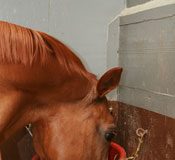Most of us harbor a dream of our horse out in a lush field of emerald-green grass, eating away the days to his heart’s content. But this picturesque vision can be more of a nightmare than a dream for horses with metabolic conditions.
High-Risk Horses
Weather conditions and pasture maintenance are the easiest things to keep an eye on outdoors; there are also some physical signs to check for in your horse.
Weather
Grasses store up the starches and sugars that trigger metabolic (slow-onset) laminitis when the weather is sunny and below 40 degrees Fahrenheit. The grass can’t put sugars to use for growth, so they get “backed up.” This often happens in spring and fall, depending on your climate.
In places like Texas, grasses get a spike in sugars when it is very hot and sunny. In places with cool-season grasses, the stress of drought will cause a sugar pile-up.

A grazing muzzle is one way to prevent a horse turned out on pasture from consuming too much grass.
Pasture Care
Pastures should be kept mowed, since the seed heads are where sugars are most concentrated. Think of them as “horse candy.” Certain broadleaf weeds left to grow out of control can also be a problem; think of how much horses like to eat dandelions, which can be very high in sugars.
Neck and Feet
Two of the fastest places susceptible horses will start to change are their neck and feet. Feel along your horse’s crest daily; if it starts to get harder or bigger, he may be close to a laminitic episode. Move him off the pasture to a dry lot or stall until weather conditions change, and feed hay that is tested to be low in sugars (or soak for several hours in a tub of water to leach out sugar content).
Trot your horse daily on hard or firm ground to see if he’s striding out as normal, or shuffling in a sore-footed manner. Any heat or obvious pulse is also a red flag to pull the horse off pasture.
Exercise
Finally, the most important thing to remember with a laminitis-prone horse is exercise. If he’s physically able, keep him in work at least three times a week. This will allow you more leeway with his diet. He should also be kept at a very trim weight and not be allowed to carry excess pounds.
Keeping your horse off pasture and giving him “diet” food may seem heart-breaking, but it is far better than seeing your friend endure a painful episode of laminitis.
Horse Illustrated Managing Editor HOLLY CACCAMISE holds an M.S. in equine nutrition.
This article originally appeared in the April 2017 issue of Horse Illustrated magazine. Click here to subscribe!







I have two ponies who wear the grazing muzzles.
Laminitis is a awefull to see and painful for the horses to experience and owners.
good advise
Nice hints and ideas.
Good practices and advise.